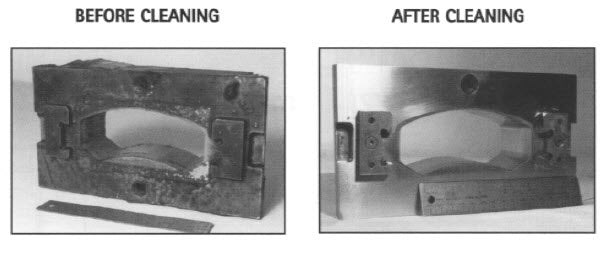Let’s take a look at the single most common ultrasonic cleaning application there is:
Cleaning oil and particulate off of metal parts. We help customers with this in industries as varied as carburetor cleaning to military weapons cleaning.
Here's a look at a Crest ultrasonic unit cleaning motor parts. Watch how the soil just leaps off the part:
Key points:
- If your parts are heavy, make sure you invest in a perforated tray or basket. These hold their shape better than mesh. This will make a difference in the long run, and make sure you don’t damage the bottom of your tank. A perforated tray is formed from stamped metal – usually with drainage holes between 1/4″ AND 1/8″.
- You are going to need heat. Not just because oil and other petroleum-based soils break down better with heat, but because ultrasonics are just more efficient above 140 F.
- If you find that you need to go to the upper end of ultrasonic compatible temperatures – say 180 f – remember that someone may need to handle the part post cleaning, so worker safety will need to be taken into consideration.
- Temperature can also be a huge help if you require a dry part. If you have a metal part with an appreciable mass, once you pull it out of the tank you’ll see that it dries by itself.
- The driving issues when you set up your metal cleaning process are these:
How clean is clean? It’s important to have an objective specification for what clean means. Here’s an example of an objective specification: “Viewed under 30x magnification, no more than three particles of soil per cm2 in excess of 0..50 are visible.” Here’s one that is not acceptable: “Gus down in receiving says that it is fine.”
What happens next? If I am going to coat the part with oil and store it, that’s one thing. If it is destined for anodizing, that is quite another. Let your needs drive your process, and let your process drive your equipment selection.
Here’s a good whitepaper Branson Ultrasonics did on this some years ago…
Aqueous Degreasing of Metal Parts (.pdf 1458kb)


 So, you’re tired of gummed up carburetors, replacing them, or at the very least paying to have them cleaned. The problem with carburetors is that they are comparatively small and very complex.
So, you’re tired of gummed up carburetors, replacing them, or at the very least paying to have them cleaned. The problem with carburetors is that they are comparatively small and very complex. So you bit the bullet, and decided to enter the world of ultrasonic firearms cleaning and re-lubrication. Thankfully you chose the best way to get started, in that you have purchased the HG575 Gun Cleaner. But now that you have it, how on earth do you use it to both clean and re-lubricate your weapons?
So you bit the bullet, and decided to enter the world of ultrasonic firearms cleaning and re-lubrication. Thankfully you chose the best way to get started, in that you have purchased the HG575 Gun Cleaner. But now that you have it, how on earth do you use it to both clean and re-lubricate your weapons?
 Nobody likes a funky monkey – or cat, for that matter. Just like human beings, all animals get dirty, and soil their environment. After a while (with some animals a SHORT while) things can get pretty messy, and if left unchecked health problems will arise. It’s our job as our animal’s keepers to keep things clean and healthy for them. But with so many things to clean, how do you go about it. One way that’s quickly catching on for a number of pet related cleaning applications is ultrasonics.
Nobody likes a funky monkey – or cat, for that matter. Just like human beings, all animals get dirty, and soil their environment. After a while (with some animals a SHORT while) things can get pretty messy, and if left unchecked health problems will arise. It’s our job as our animal’s keepers to keep things clean and healthy for them. But with so many things to clean, how do you go about it. One way that’s quickly catching on for a number of pet related cleaning applications is ultrasonics. Ultrasonic cleaning has been around since the 50’s, and as more and more people learn about it’s amazing qualities, it’s seeing use in applications as varied as cleaning dental instruments, to, well, cleaning golf supplies. But how does this ultrasonic golf club cleaning machine do what it does?
Ultrasonic cleaning has been around since the 50’s, and as more and more people learn about it’s amazing qualities, it’s seeing use in applications as varied as cleaning dental instruments, to, well, cleaning golf supplies. But how does this ultrasonic golf club cleaning machine do what it does?